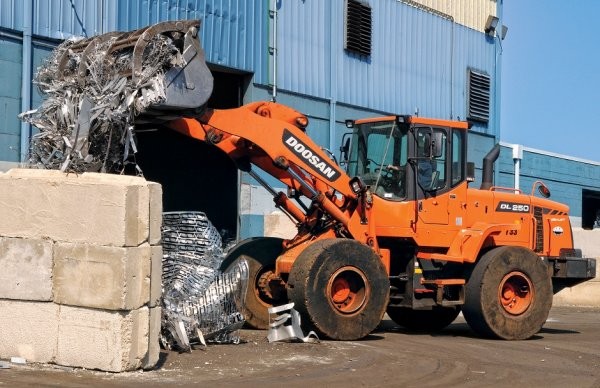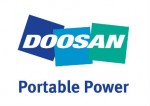Recycling today's resources for tomorrow's future
Michigan recycler selects Doosan wheel loader with high-lift capabilities for day-to-day material handling

There may not be an industry or application that is tougher on equipment than scrap metal processing and recycling. Between hard-to-handle materials, heavy objects and long hours, equipment is expected to perform day in and day out, without a breakdown.
Located in Western Michigan, in the heart of Kalamazoo, is Schupan & Sons Inc. The company was started by Nelson Schupan in 1968. Today, the company employees about 400 people, with 10 locations total in Michigan, Illinois, Indiana and Ohio, and in August 2012, the company expanded to enhance its position in the marketplace.
Facility and Equipment Manager Rick Hutchins has nearly 30 years of tenure at Schupan & Sons, and is based at the facility in Kalamazoo, Mich. The facility is one of two scrap recycling processing centers; the other in Elkhart, Ind. Additionally, the company has two beverage plants in Michigan &mdash one in Grand Rapids and one in Wixom &mdash a brokerage office in Chicago and aluminum and plastic sales distribution, with locations in Kalamazoo and Detroit, Mich., and Toledo and Dayton, Ohio.
The company’s process is simple: Buy scrap and process it for the mills, whether it is baled, boxed or shredded. “Our biggest amount of volume is our non-ferrous material,” Hutchins says, “whereas our ferrous division is about a 5,000-metric-ton-a-month volume.” Hutchins says the company has survived the economic challenges in Michigan and national economic adversities because of strong leadership.
Forward thinking
Schupan & Sons is led by Marc Schupan, son of founder Nelson Schupan, along with his brother Dan and Sister Dana Wardlaw and, according to Hutchins, is always looking for new ways to increase their sales and marketing abilities in the three different divisions.
“Marc is a person who believes the best people win,” he says. “He is someone who I call a forward thinker. Our aluminum sales division came from his idea of being a niche between the big suppliers of aluminum and the small job shops that couldn’t afford to buy large quantities.”
Schupan started a beverage container recycling division in 1986 and just seven years later, had recycled one billion aluminum cans. Another example of Schupan’s success can be found in the beverage division. Schupan & Sons has become a top-five company in the nation for beverage can recycling. In 1997, Schupan started the largest-volume beverage container recycling program in the United States, partnering with a Norwegian company called TOMRA.
Metal handlers
At the Elkhart facility, Schupan & Sons needed a more powerful machine that was capable of lifting material and dumping it into open-top trailers. When it was time to evaluate his options, Hutchins looked at three different machines. One of his key measurements was the cost-per-hour for five years. The local Doosan dealer &mdash Carleton Equipment &mdash and another heavy equipment dealer provided the numbers Hutchins needed. Both dealers were selected for an onsite demonstration. Hutchins asked Carleton Equipment and the other equipment dealer to bring their wheel loaders to the Elkhart plant for a side-by-side comparison, and he asked the operators to drive and evaluate both machines, inside and out.
“The best indicator of the machine’s performance and comfort is the operator,” Hutchins says. “He’s the guy who will run it all day. By having the guys compare both models, it was a really good test of the machines. We liked the Doosan wheel loader and the per-hour costs that the dealer provided to us.” What initially pushed Hutchins and the operators toward the Doosan wheel loader was its appearance.
“The operators liked the stoutness of it,” he says. “We like strength and the Doosan wheel loader looks strong. The strength of the machine is important because we’re pushing, especially in steel turnings. If we want to load some steel bushing, it’s tough on the machine, really tough. In the end, we felt the Doosan wheel loader was going to do us a better job and going to last longer. It will go until its end; we won’t trade it in.”
After about a year on the job, the Doosan DL250 has about 1,400 hours on it, and Hutchins expects it to average about 2,000 a year, roughly four or five hours a day. “In our industry, abuse may be just operation because we’re hard on equipment,” Hutchins says. “Many will say that’s abuse, and we’ll say that it is inherent to our business.”
Jeff Neidlinger is the plant manager at the Schupan Industrial Recycling center in Elkhart, and he is the primary operator of the Doosan wheel loader. His first impression of the Doosan wheel loader was a positive one.
“It looked really sturdy, especially on the front arms where the bucket attaches,” Neidlinger says. “We do a lot of pushing, and the machine looked very sturdy.”
A big selling point for Neidlinger was the Doosan wheel loader’s cab. “The cab is very comfortable,” he says, “and the visibility is excellent. I can glance to one side or the other and see everything behind me, which is important because there are a lot of close quarters here, and a lot of activity. And, of course, I like the radio, heat and good air conditioning; it’s a joy to work with and work in it.” Much of Neidlinger’s workday is spent sorting materials, loading several trucks and pushing scrap material into bins. When loading, he appreciates the high lift capability of the DL250.
“The open-top trailers are 13 feet 6 inches high on the sides and are 10-feet wide,” Hutchins says. “We bulk load into those and we’ll take them to the mills. We wanted a wheel loader with high lift to go over the top of that. We can easily clear it with our Doosan DL250. We didn’t want to be just high enough from the hinge pin of the bucket to the top of the trailer. We wanted to take the lift all the way up, put the bucket all the way down, and the blade would clear the top of our trailer. And it does that.”
Sorting made easier
While the types of materials coming into the Elkhart facility may differ, the process for how they’re handled is seamless. Hutchins says Schupan employees separate loads when they arrive and grade them, in a 2-foot or 5-foot length.
“We grade scrap the way the mills want to process it,” Hutchins says. The sorting is done much more efficiently today than before. Previously, Hutchins says Schupan crews moved cranes out of production and helped load scrap materials into containers. He says with a crane and grapple, his crews were only getting half as much as a bucket and grapple on the front of a wheel loader.
“The ability to push the piles up higher was the other reason we selected a wheel loader with high lift,” Hutchins says. “We want to push our piles up higher. We have to start on the bottom and as we work up, as we work it up the pile, the resistance from the pile becomes more and more. The predecessor to our Doosan wheel loader didn’t have enough power to get those piles higher in the bin. The Doosan wheel loader can get them in and push them right up; our bins are only so big and we have to get them in there. We take them from the bin and dump them into the baler.
“Our productivity with the Doosan wheel loader has increased 100 percent over what we could do with our previous machine,” Hutchins explains.
Partnership in recycling
Schupan & Sons and its recycling facilities have gone beyond just accepting material from their customers, partnering with them to help them improve the value of the recyclables.
“We’ll visit our customers and tell them, ‘you have this amount of scrap, and we’re going to teach you how to make more money,’” Hutchins says. “Sometimes customers are comingling it all together. We’ll provide containers to help customers sort it. We work with our customers to help them get the best value out of their scrap. We don’t know anything about the widget they’re making, but we do know what to do with the scrap that is coming off of it. “Marc Schupan built our business on service,” Hutchins says.
“Customers are the No. 1 priority for us. We’re an honest company. We pay for every pound or ton that we purchase. This is a tough industry and it’s not promoted well.”
Dealer support
Long before Schupan purchased its Doosan wheel loader, it had a strong relationship with Carleton Equipment for compact equipment needs, specifically Bobcat® skid-steer loaders. Schupan has been a Bobcat skid-steer loader customer of Carleton Equipment for more than 30 years. Like the dependability of its Doosan wheel loader, Schupan required durable compact equipment for its processing and pushing needs.
“Throughout the years, it has been the solid relationship between Schupan and Carleton Equipment that has helped make us successful,” Hutchins says. “We’ve been able to run our Bobcat loaders at a cost-per-hour less than a good share of them. Carleton Equipment is always there for us.”




